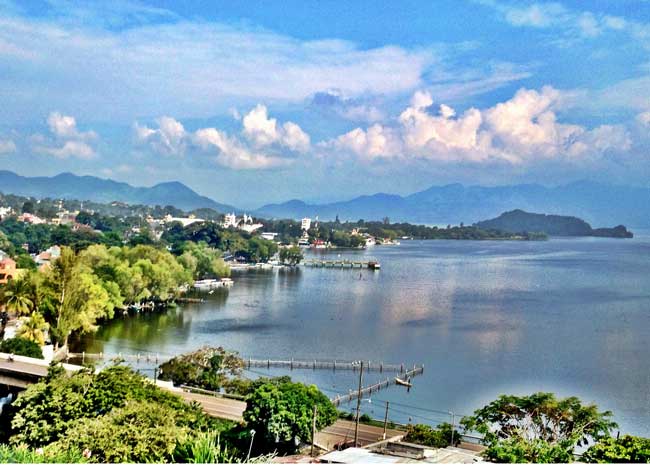
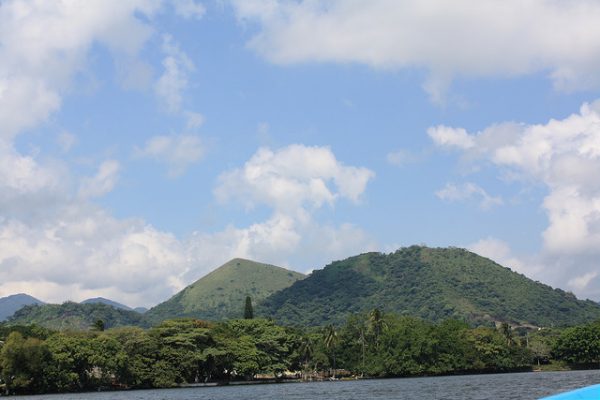
Travel to Los Tuxtlas
Popping out of a lonely green corridor splitting the mountainous forest, I stopped to gaze down the highway. “What kind of enchanted land have I entered?” I wondered aloud.
To the right, unpopulated sandy, subtropical beaches shimmered toward the horizon. To the left, the thick forest ebbed and prairie-like pasture covered the hills rumbling toward the sea.
Los Tuxtlas Mountains crowd southeastern Mexico, north of the Yucatan. They are a range of low volcanoes that span in elevation from sea-level on the Bay of Campeche to over 1,700 meters, in the most northerly tropical rain forest on earth.
This region embraces the Olmec culture.
Being the home of the Olmecs is mysterious enough, but the countryside, vegetation and black-earth odors enhance the puzzle of this lost civilization.
The geological features—from beach to crater to steep-walled canyons in a humid, tropical climate—create an astounding diversity of micro-climates and terrain.
Over 3,000 plant species and 550-plus bird species thrive in the Sierra de los Tuxtlas. Laguna Catemaco, seven miles long, four wide and 98 feet deep at its maximums is formed from the calderas of extinct volcanoes.
Mexican Highway 185, a narrow, two-lane road, snakes through Los Tuxtlas’ low-lying mountains. Two autopistas, or toll roads, completely bypass the region, keeping the land isolated and relatively unspoiled.
The tourist, adventurer or explorer, with effort, can find unknown Olmec ruins, artifacts and sculptures hidden in the jungle.
Thankfully, numerous little-known tourist sites and archeological digs nearby dissuade the unprepared visitor from emulating Indiana Jones and taking on the terrain in search of the next major archeological find.
A poorly marked road circles Volcán San Martin and Reserva de la Biosfera de Los Tuxtlas and runs along the coast.
It’s a day’s ride, if sightseeing, devoid of five-star luxury, but brimming over with nature’s raw beauty. A lucky few enjoy that circular exploration once.
The really lucky drive it several times and stretch stops at different sections into longer ventures to absorb the unadvertised sites, such as a rocky island colored white from nesting birds, and drink in the lifestyle of Old Mexico.
Catemaco anchors the Los Tuxtlas region. Surrounded on three sides by tropical jungle, the picturesque town nestles beside the mysteriously inviting Catemaco Lagoon.
Among other lakeside attractions, tour boats visit an island inhabited by monkeys and includes the Reserva Ecológica Nanciyaga, (Nanciyaga Ecological Reserve).
“The Medicine Man,” starring Sean Connery, and “Apocalypto,” directed by Mel Gibson, were filmed there.
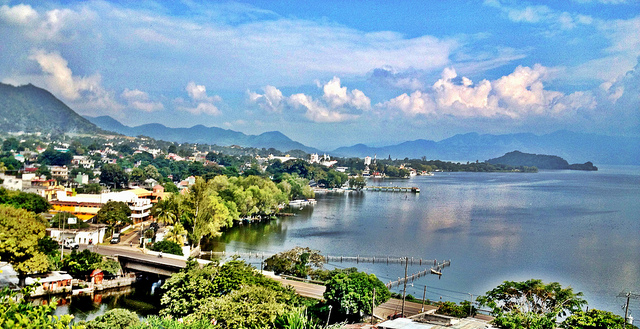
Catemaco, Veracruz Mexico
Although a few larger towns dot the region, Catemaco is an excellent base from which to explore Los Tuxtlas.
The town offers numerous accommodations and restaurants, with fresh fish straight from the lake and seafood from the ocean less than thirty miles away.
Catemaco is the center of brujas, or witches, in Mexico, and is internationally known by those interested in the mystical side of life.
Paranormal shops, medicine men, and fortune tellers are sprinkled throughout the town. The Festival of Witches, a lighthearted celebration, occurs during March.
On the serious side, many believe the magic and supernatural atmosphere hearkens back to pre-historic Olmec celebrations.
Medicinal plants grow in these forests, and bubbling springs and waterfalls add to the other-world ambiance. In isolated villages, one can find respected men we’d term herbalists or root doctors.
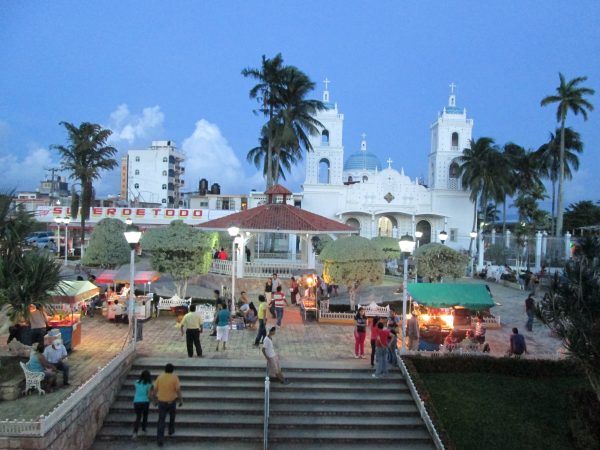
A tourist map is available at most hotels. My 30-mile driving error taught me to use it as a general guide, not for specific highway directions.
The smaller roads twist and turn and don’t always correspond to the geographical features on the tourist map.
Moving northeast toward the village of Sontecomapan, the potholed lane is a jolting experience the first 10 miles.
A careful driver can navigate the road, avoiding the basket-sized scoops. However, the country scenery of giant trees and lush two foot-high pasture grass proved too eye catching.
I slowed down, hit half the potholes, and enjoyed the countryside which beckoned, “Stop and enjoy a picnic.”
The map indicates villages’ dotting the next 40 miles, but the settlements are off the road and unseen. A lone driver is in splendid isolation.
Just when glimpses of the bay show between branches and the road reaches perfection, it’s time to slow to a crawl. Mountain jungle crowds the lane.
Tropical vegetation permeates the air and fills your lungs as you bump over three miles of stone road. A turn left heads into Reserva de la Biosfera de Los Tuxtlas.
Passing the Reserve, the bumping continues for a short distance, and the road becomes smooth again. Dirt roads to the right lead to little beach villages set several hundred yards in from the sand.
The first fishing village I visited was Balzapote, and I had the coast to myself. The wild ocean reminded me more of west coast Mexico than the Caribbean or Gulf shores.
It’s as if God had jammed America’s Great Smoky Mountains against the ocean, 1,500 miles south.
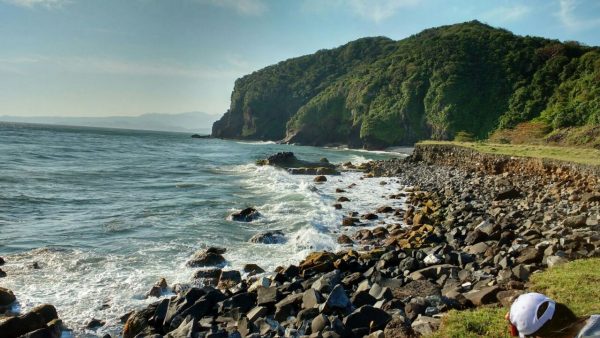
Travel to Monte Pio
Monte Pio, with perhaps 80 houses, loomed as the closest any settlement came to being a town. Few people frolicked on the three-quarter-mile stretch of beach, and two guys slept off a great fiesta.
The air felt cool with the ocean breeze, but I empathized for them knowing the misery the tropical sun would add to their hangovers.
Leaving the village wild, lush, wind-swept pasture-lands roll off low hills abutting the beaches.
Thankfully there was no traffic, and I eased along even stopping in the road to admire scenery and take pictures.
I pulled off at a beach near Punta Roca Partida, in sight of the lighthouse, for a shrimp lunch. The meal was served in the side yard of the fisherman’s house under the shade of several banana and coconut trees.
A line of small firs separated the small yard from the sandy beach. I struck up a conversation with a couple from San Andres Tuxtla, while their maid and two children enjoyed plates of fish at a table a few feet away.
“Make sure you visit the pirate’s cave hidden over there,” the husband said pointing at a rocky cliff meeting the ocean. “A local fisherman carries people there for a few dollars.”
Because I wasn’t planning to spend the night, I decided to save that adventure for another trip.
Punta Roca Partida
While walking the beach at Punta Roca Partida, two thoughts competed. First, I wished I was 30 years younger.
What an opportunity for a young person to purchase a hundred-plus acres of virgin beach land as beautiful as any the big hotel corporation sculptured for tourists.
The second thought was: why ruin this paradise by building or telling anyone where it is? It’ll get discovered eventually.
Hopefully, people will be wise enough to visit now or purchase land in a manner to keep it pristine.
Finishing my meal and saying good-by to the hospitable family, I continued my journey.
Charming beach settlements dotted the coastal blacktop until the road curved south returning to Catemaco. The return route can go through either Santiago Tuxtla or Tres Zapotes. Either choice is a winner.
Tres Zapotes, on the western edge of Los Tuxtlas, is both a town and an archeological site. The first of the 17 known colossal Olmec heads was unearthed in 1862.
A second has since been discovered in the immediate area. Each of the Tres Zapotes basalt heads measures a little less than four-and-one-half feet tall.
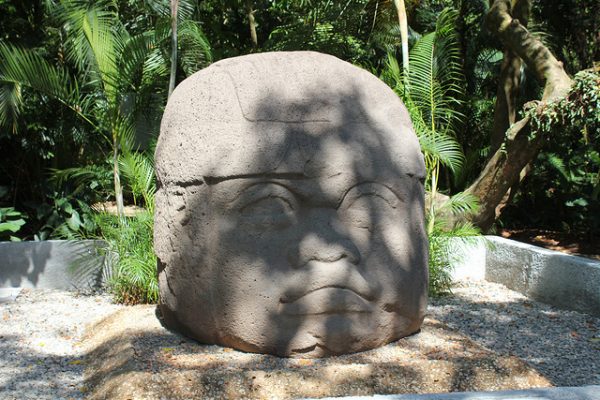
The Olmec civilization may date as early as 1500 B.C. and continued until 100 A.D. Olmec traditions at Tres Zapote carried further into the Mayan period than at any other known Olmec settlement.
Perhaps the most important archeological find is Stela C, carved from basalt. On one side are Olmec-style engravings, while the other side boasts the second oldest Mesoamerican Long Count calendar.
Local rumors persist Jesus Christ spent time in the area after he arose from the dead. It sounds like a stretch, but I’ve seen a pottery head that resembles Christ.
One can only wonder what mysteries, secrets and ancient rites are tied into the lifestyle of the region, even today.
Somehow ancient mysteries bubble forth to make Catemaco internationally famous with witches, warlocks and other practitioners of the occult.
Knowing our own Christmas tree and Maypole traditions reach back to prehistoric eras, I hope anthropologists and ethnologists delve into modern village practices to discover what survives from three thousand years past.
Leaving Tres Zapote, the highway skirts both Santiago Tuxtla and the area’s largest city, San Andres Tuxtla, known for its hand-rolled cigars.
Having driven through the maze of streets and marveled at their ancient edifices, both cities warrant a revisit.
However, my time was running short so I headed for the town of Sihuapan, the home of Te-Amo, the most famous Mexican cigar brand to end a perfect day enjoying a deluxe smoke.
I first motorcycled through Los Tuxtlas in 1971 and hurried through many other times to reach another destination.
After finally slowing up to enter the first low mountains of Los Tuxtlas for a true look, I realized this was enchanted rainforest.
On my first visit about 12 years ago, I pulled onto the lakeside in Catemaco for a five minute stop. I ended up staying 17 days before revisiting a second and third time for a week each.
My next seven visits exceeded month-long stops as I re-explored what I’d discovered and sought other delights hidden in the region.
If you visit Mexico and can escape the famous tourist enclaves, you will be well rewarded by Los Tuxtlas.
If You Travel to Los Tuxtlas
There are a number of hotels around the region. The few hotels and cabanas near the beach areas are more typical of an older Mexico, this style and may have a claustrophobic sensation.
There are a few newer hotels being built too.
Santiago Tuxtla & San Andres Tuxtla provide good hotels but the main town for accommodations is Catemaco. Inns range from basic rooms for next to nothing, to five star hotels.
I am recommending four I have used and been satisfied with. Do not let my recommendations limit you in your search, especially if you are not on a budget. There are many other fine hotels in Catemaco.
Hotel Los Arcos
(294)-943-0003
Hotel Los Arcos straddles the block between the lake and the central plaza, next to the town market. It is a block up from the lake and two short blocks from the plaza.
Normally costing about forty to fifty dollars a night. The hotel is well-run with an older and more modern side.
La Casa Rosa
(294)-943-0386
La Casa Rosa is located two blocks from the plaza. It is a wonderful B&B run by a German immigrant. Prices often run in the mid-twenties.
Hotel Posaa Konneapan
(294)-943-0063
Posada Konneapan resembles an American beach motel from the 1960s. It is located next to one of the bus stations and is across the street from Laguna Catemaco. Look for costs to be about thirty-five dollars.
Posada Bugambilias
(294)-110-0180
This too is more a B&B than a hotel. The drawback for some is the fact it is located on the edge of town. The cost should be about twenty dollars.
All these places have excellent, friendly owners. They will bend over backward to aid their guests with information to find various locations. Your ability to bargain may get you better rates than listed.
Author Bio: William B. “Bill” Kaliher has traveled Mexico at every opportunity since the 1960s by car, bus, train and motorcycle. He has written for the Mexican Ministry of Tourism. Although known for his Mexican travel articles he’s written for over 600 publications including The World & I, The Pragmatist and Down Memory Lane. His book, Mexico by Motorcycle: An Adventure Story and Guide, has garnered five star reviews, been covered in several magazines and recommended by expats who have resided in Mexico for years. Perhaps, the top compliment was by a review who wrote, “This reads like a novel.”
- What It’s Like to Live as an Expat: Lake Chapala, Mexico - April 18, 2024
- Top 5 Spots for Stargazing in North Carolina - April 17, 2024
- The Low-Key Magic of Ghent, Belgium - April 17, 2024
